Overview
Private real estate investing presents a compelling opportunity for new investors seeking a hands-on approach to acquiring non-publicly traded properties. This avenue can yield significant returns, but it is essential to acknowledge the inherent risks involved. The article delineates various investment strategies, including:
- Buy-and-hold
- Fix-and-flip
It underscores the necessity of thorough market analysis and goal-setting. Such strategies are crucial for effectively navigating the complexities of this investment sector. By understanding these dynamics, investors can better position themselves for success.
Introduction
In the dynamic realm of real estate, private investing stands out as a compelling avenue for individuals aiming to build wealth and diversify their portfolios. Unlike traditional public investments, private real estate encompasses a diverse range of assets that remain untraded on stock exchanges. This unique characteristic offers investors the opportunity to engage directly with properties and capitalize on distinctive market opportunities. As the landscape evolves, projections suggest that private investments could dominate by 2025, drawing both seasoned investors and newcomers with the promise of potential capital appreciation and consistent rental income.
However, navigating this intricate arena necessitates a keen understanding of various strategies, robust financial planning, and the ability to conduct thorough due diligence. This article delves into the essential aspects of private real estate investing, providing valuable insights into effective strategies, goal-setting, and the significance of cultivating a strong network to ensure success in this ever-evolving market.
Understanding Private Real Estate Investing
Private property investing encompasses the acquisition of assets that are not publicly traded, including residential properties, commercial structures, and undeveloped land. This investment approach stands in contrast to public property holdings, such as Real Estate Investment Trusts (REITs), which are traded on stock exchanges and offer a more passive funding model. Engaging in private investments typically necessitates a hands-on approach, often involving direct management of properties, which can lead to both heightened risks and potentially greater rewards.
In 2025, private property investments are projected to represent a significant portion of the overall market, with approximately 70% of property investments being private compared to 30% public. This shift underscores the increasing enthusiasm among financiers eager to capitalize on the unique opportunities presented by private assets.
Current trends indicate that private property investment is gaining traction due to its potential for capital growth and the ability to generate consistent rental income. New entrants are particularly drawn to this sector as it facilitates portfolio diversification, thereby mitigating risks linked to market volatility. Nonetheless, it is essential for stakeholders to remain cognizant of the inherent risks associated with private property investing.
Factors such as escalating construction costs, inventory shortages, and the influence of political policies can introduce instability into the market. Notably, around 30% of construction workers are immigrants, which can impact labor availability and costs within the sector. For instance, as of September 30, 2024, significant redemption queues in the NFI-ODCE Index revealed a cautious sentiment among investors, with $34 billion, representing 16.4% of net asset value (NAV), being withdrawn. This scenario reflects the challenges confronting the property market, as illustrated by the case study on the challenges anticipated in 2025, where rising costs and political uncertainties—especially regarding Trump's policies—are expected to create volatility and influence market dynamics.
Successful case studies in private real estate investing highlight the necessity of strategic planning and thorough market analysis. Investors who adapt to prevailing trends and leverage expert insights can effectively navigate the complexities of the market. As asset managers forecast a total increase of 6.6% for the NPI in 2025, with expectations for a stronger rebound in 2026, the potential for lucrative returns remains compelling for those prepared to engage actively in private property ventures.
Exploring Different Private Real Estate Strategies
Investing in private real estate encompasses a variety of strategies, each tailored to different investor goals and risk tolerances. Here are some of the most prominent approaches:
- Buy-and-Hold: This strategy involves purchasing properties with the intention of renting them out for long-term income. Investors benefit from steady cash flow and potential appreciation in property value over time. Recent statistics indicate that buy-and-hold strategies have a success rate of approximately 85% in generating positive returns, particularly in stable markets. Lawrence Yun, Chief Economist at the National Association of Realtors, notes that "home sales momentum is building," which further supports the viability of this strategy in the current market.
- Fix-and-Flip: This approach focuses on acquiring undervalued properties, renovating them, and subsequently selling them for a profit. The profitability of fix-and-flip investments has been notable, with recent data showing an average return on investment (ROI) of 40% for successful flips in 2025. Successful financiers often emphasize the importance of thorough market research and budgeting for renovations to maximize profits.
- Real Estate Syndication: This strategy allows investors to pool resources with others to purchase larger properties, such as apartment complexes or commercial buildings. Syndication can reduce personal risk while offering access to higher-value assets. It is particularly appealing for those looking to diversify their portfolios without the burden of managing properties directly.
- Commercial Real Estate: Investing in office buildings, retail spaces, or industrial properties can yield higher returns compared to residential investments. However, this strategy often comes with increased risk and requires a deeper understanding of market dynamics. Investors should be aware of current trends, as commercial property has experienced a resurgence in interest, with many experts predicting ongoing growth in this sector.
Each of these strategies in private real estate investing carries its own risk profile and potential returns, making it crucial for individuals to select one that aligns with their financial objectives and the current market conditions. By grasping the subtleties of each method, individuals can make knowledgeable choices that improve their prospects of success in the competitive property market.
Moreover, the Law of Three is a marketing approach that streamlines decision-making in property by restricting selections to three alternatives. This principle can be particularly advantageous for investors when assessing potential opportunities. A case study on the Law of Three demonstrates how simplifying choices can enhance client interactions and decision-making in property investments.
Furthermore, survey participants show a favorable shift in sentiment concerning property prospects, with anticipations of enhanced revenue growth and transaction activity. This emphasizes the significance of remaining informed and flexible in this changing market.
Defining Your Real Estate Investment Goals
Establishing specific, measurable, achievable, relevant, and time-bound (SMART) goals is essential for successful private real estate investing. Key considerations guide you in defining your financial objectives:
- Income Goals: Identify the amount of passive income you aim to generate. Recent statistics indicate that new investors often target an average passive income of $2,000 to $5,000 per month, reflecting a growing trend towards financial independence through private real estate investing.
- Appreciation Goals: Set clear targets for property value increases over time. Historical data indicates that properties can appreciate significantly, with optimal opportunities lasting up to seven quarters after the dot.com bust and a complete 14 quarters after the Global Financial Crisis. This understanding can assist you in timing your financial placements effectively.
- Financial Horizon: Determine whether your focus is on short-term gains or long-term wealth accumulation. Comprehending your financial horizon can assist in customizing your strategy to align with market cycles and personal financial objectives.
By clearly outlining these objectives, you create a targeted strategy that corresponds with your financial aspirations. Financial consultants emphasize the significance of goal-setting in private real estate investing, highlighting that a clearly outlined plan can lead to more informed choices and greater success in achieving financial objectives. As Deloitte indicates, despite the business rationale for sustainability strategies gaining traction, companies must balance immediate financial gains with enduring advantages.
For example, a case study on successful property stakeholders showcases how they established specific appreciation objectives, leading to a 20% rise in asset values over five years. This method not only optimized their gains but also offered a clear plan for future private real estate investing.
In 2025, as the commercial property cycle indicates signs of a positive shift, aligning your investment objectives with market trends will be essential. MetLife Investment Management expects 2025 to be an outperforming vintage for many property types, indicating a favorable environment for private real estate investing. With 97% of industry experts dedicated to embracing innovative solutions, including AI, to improve operational efficiency, the environment for property investing is changing.
Embracing these changes while adhering to SMART goal principles can position you for success in this dynamic market.
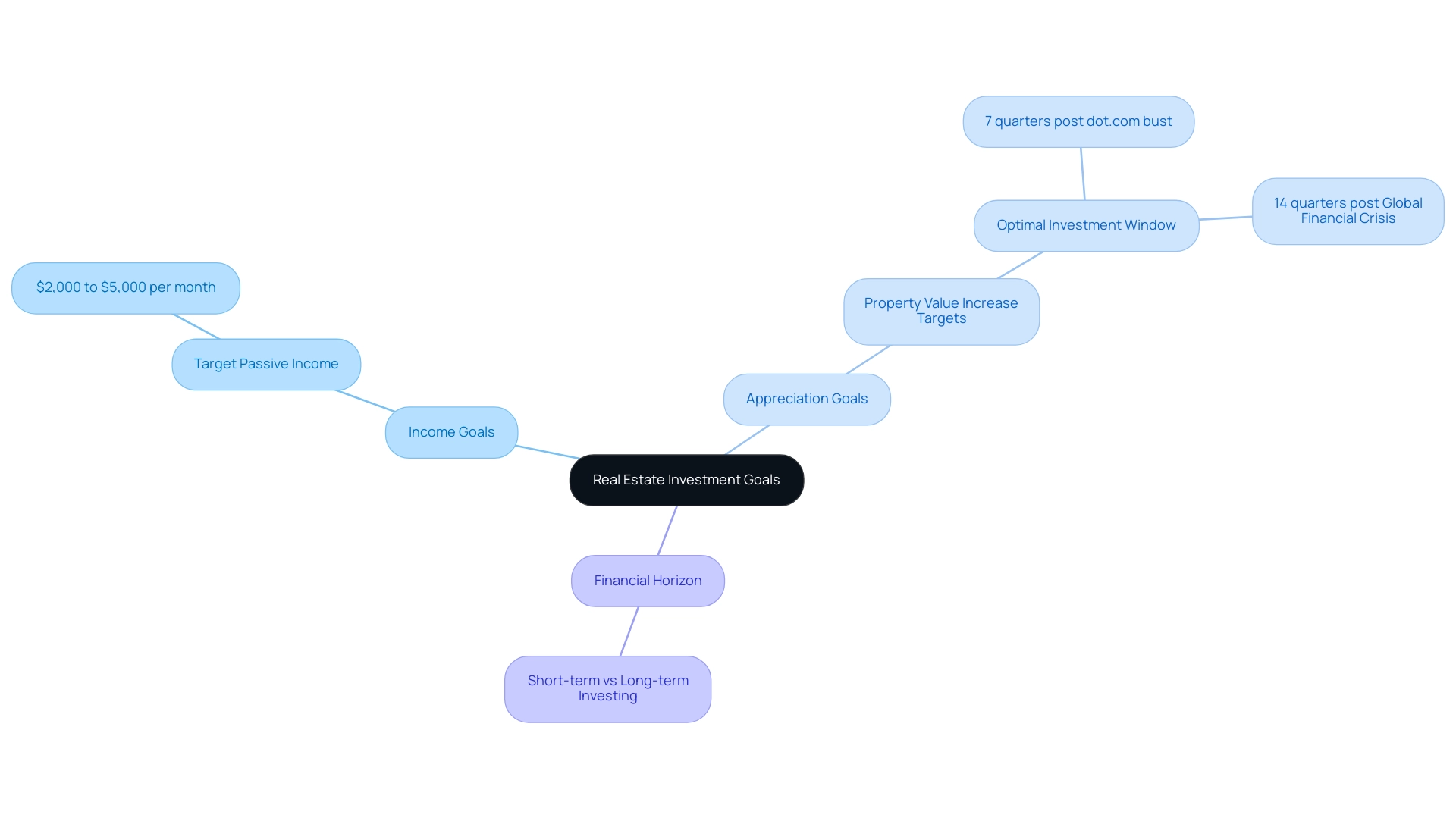
Creating a Financial Plan for Real Estate Investments
A well-structured financial plan for real estate investing is essential for success, encompassing several key components:
- Budgeting: Start by outlining your initial investment, ongoing expenses, and potential income. This includes not only the purchase price of the property but also costs such as property taxes, insurance, maintenance, and management fees. For new investors, the average budget can vary significantly; however, understanding these elements is crucial for realistic financial forecasting.
- Financing Options: Explore various financing methods available in 2025, including traditional mortgages, partnerships, and private loans. Each option presents its advantages and disadvantages, and selecting the right one can significantly affect your profitability. As Keith Gumbinger, vice president at HSH.com, states, "For the best possible outcome, we’d first need to see inventories of homes for sale turn considerably higher," emphasizing the importance of market conditions in financing decisions. Currently, the existing inventory stands at a 4.2 months' supply, down from 4.3 months in October 2024. This indicates a competitive market that may impact your financing strategies. Furthermore, obtaining pre-approval from a reputable lender is crucial for understanding your budget and strengthening offers in this competitive housing market.
- Cash Flow Analysis: Conduct a thorough cash flow analysis to project your income against expenses. This step is vital to ensure that your assets will generate sufficient income to cover ongoing costs. A positive cash flow not only supports your current financial obligations but also contributes to long-term wealth creation.
- Contingency Planning: Prepare for unexpected costs or market downturns by establishing a contingency fund. Setting aside reserves can safeguard your investments against unforeseen challenges, ensuring that you remain financially stable even in fluctuating market conditions. The case study titled "Trends for Real Estate Industry in 2025" emphasizes the urgent need for leaders to transform their strategies in response to socio-economic disruptions, which is critical for effective contingency planning.
By establishing a robust financial plan that incorporates these elements, you can navigate the complexities of real estate investing with confidence, positioning yourself for success in a competitive landscape.
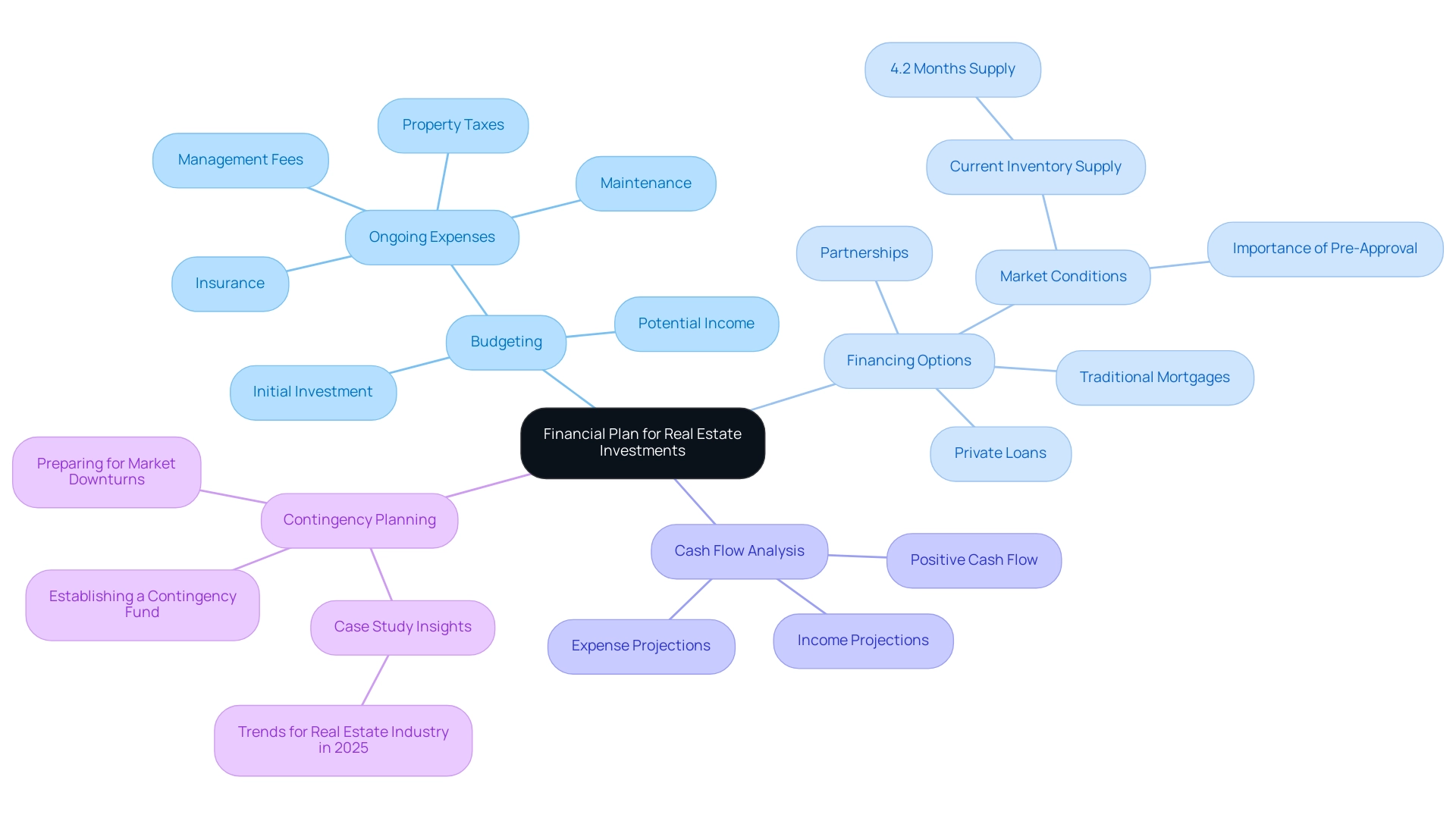
Conducting Due Diligence in Real Estate Investments
Due diligence is a critical process that entails a comprehensive investigation of a property prior to purchase, ensuring that buyers make informed decisions. The key steps in conducting due diligence include:
- Property Inspection: Engaging qualified professionals to evaluate the physical condition of the property is essential. Inspections often reveal significant issues, with common problems related to roofs (19.7%), electrical systems (18.7%), and windows (18.4%), as noted by Tony Mariotti. Understanding these factors can prevent costly surprises post-purchase.
- Market Analysis: Investors should conduct extensive research on local market trends, property values, and rental rates. This analysis helps identify potential investment opportunities and assess the viability of the property in the current market landscape. For instance, the new home premium has been noted to decrease by 0.85% each year, indicating changing dynamics that stakeholders must consider.
- Financial Review: A thorough financial evaluation of the property is essential. This includes analyzing income statements, expense reports, and understanding the overall financial performance. Sellers typically retain 94–95% of any increase in price, underscoring the importance of accurate financial projections.
- Legal Checks: Verifying property titles, zoning laws, and any existing liens or encumbrances is vital to avoid legal complications. Misrepresentation of a property's condition is a frequent problem in property transactions, highlighting the importance of understanding property disclosure laws. This emphasizes the significance of performing comprehensive legal reviews as a component of the due diligence procedure.
Carrying out thorough due diligence in private real estate investing not only mitigates the risk of unforeseen problems post-purchase but also enhances the investor's confidence in their financial choices. As demonstrated by case studies, such as the analysis of network effects in property brokerage, effective due diligence practices can lead to successful outcomes, while neglecting this step can result in significant financial setbacks. Real property professionals emphasize that adhering to best practices in inspections and due diligence is paramount for achieving long-term success in private real estate investing.
Furthermore, with Zero Flux curating data from over 100 diverse sources and boasting over 30,000 subscribers, stakeholders can trust that the insights they receive are grounded in data integrity and reliability.
Navigating Real Estate Investment Platforms
Participants can utilize a range of platforms to access exclusive property opportunities, each providing distinct benefits.
- Online Marketplaces: Platforms like Fundrise and RealtyMogul enable participants to discover and invest in various property projects. These marketplaces have gained popularity due to their user-friendly interfaces and the ability to engage in private real estate investing with relatively low minimums, making property accessible to a broader audience.
- Crowdfunding Platforms: These platforms facilitate private real estate investing by allowing multiple investors to pool their resources for larger projects, effectively reducing individual risk. The property crowdfunding market is anticipated to expand considerably, with projections indicating it might attain a market size of $300 billion by 2025. Successful examples of private real estate investing include projects financed through platforms like Crowdstreet, which have shown significant returns for investors.
- Property Investment Trusts (REITs): While not strictly private, non-traded REITs offer a method to invest in property without the necessity for direct ownership. They provide liquidity and diversification, attracting those seeking a more passive approach to their finances.
- Local Groups: Joining local real estate clubs can open doors to exclusive deals and valuable networking opportunities in private real estate investing. These groups frequently exchange insights and strategies that can improve financial success.
Choosing the appropriate platform for private real estate investing depends on personal financial goals, risk tolerance, and the preferred level of involvement. For instance, listings promoted with 3D tours receive 87% more views, emphasizing the significance of leveraging technology in financial strategies. Moreover, high-quality images enhance the perceived worth of a property for 83% of purchasers, highlighting the importance of presentation in property investments.
As the scenery changes, remaining updated on the latest trends and statistics—such as the fact that 44% of marketers are currently using AI to enhance agent efficiency—will be essential for making informed choices in the property market. Furthermore, with more than 30,000 subscribers, Zero Flux serves as a reliable source of insights, demonstrating its authority in the property community. Understanding buyer preferences is also essential; for example, 78% of homebuyers value neighborhood quality over home size, with 57% preferring a shorter commute, as noted by REsimpli.
This insight can assist individuals in making strategic decisions that align with market demands.
Understanding Real Estate Crowdfunding
Property crowdfunding has emerged as a revolutionary method in private real estate investing, enabling participants to pool their resources to finance various property projects. This innovative investment model presents several key benefits that are particularly advantageous for new investors:
- Lower Minimum Investments: Numerous crowdfunding platforms have significantly lowered the barrier to entry, allowing investments to commence as low as $500. This accessibility empowers new participants to engage in private real estate investing without the need for substantial capital. By diversifying their capital across multiple projects, individuals can considerably reduce their risk exposure. This strategy is essential in a market where fluctuations can adversely affect individual investments, particularly in private real estate investing.
- Access to Larger Deals: Private real estate investing through crowdfunding opens doors to high-value projects that may otherwise be unattainable for individual investors. This access enables participants to capitalize on lucrative opportunities, such as commercial properties or large residential developments.
- Passive Income: Investors can earn returns through private real estate investing without the burdens associated with property management. This feature is especially appealing for those seeking to generate income while maintaining a hands-off approach.
As the trend of private real estate investing continues to gain momentum, understanding how to effectively navigate these platforms is crucial for new participants. By 2032, the market for private real estate investing is projected to reach USD 15.0 trillion, underscoring the growing significance of this investment avenue. Successful individuals emphasize the importance of educating oneself about the various platforms and projects in private real estate investing to avoid potential pitfalls.
Akira Yamaguchi, a property economist, advises, "My tip for potential investors in private real estate investing: educate yourselves about the platforms and projects to avoid pitfalls."
Moreover, private real estate investing in sustainable and eco-friendly projects can yield rewarding opportunities, aligning financial goals with social responsibility. This aspect is increasingly relevant as Zero Flux highlights the focus on sustainability in crowdfunding, which could lead to private real estate investing in eco-friendly and affordable housing projects.
Furthermore, case studies illustrate the successful application of blockchain technology in private real estate investing, particularly in property crowdfunding, which enhances transparency and efficiency in transactions. These advancements not only make private real estate investing more accessible but also foster trust among stakeholders. As the landscape evolves, staying informed about the latest crowdfunding trends and strategies will be essential for those aspiring to succeed in private real estate investing.
Building a Network: The Role of Investment Clubs
Becoming a member of a group focused on private real estate investing presents numerous advantages that can significantly enhance an individual's journey. Key advantages include:
- Knowledge Sharing: Members engage in a collaborative environment where they exchange insights, strategies, and personal experiences, deepening their understanding of market dynamics. This collective wisdom is invaluable, particularly for those new to the field. The importance of remaining knowledgeable is underscored by Zero Flux, which compiles 5-12 selected property insights daily, providing essential information that aids in decision-making.
- Networking Opportunities: Investment clubs frequently organize events that foster connections among financiers, potential partners, lenders, and mentors. These interactions can lead to fruitful collaborations and partnerships that may not be achievable in isolation. Research consistently shows that individuals involved in property groups tend to achieve higher returns on their capital compared to those pursuing independent endeavors.
- Access to Resources: Many clubs provide educational materials, including workshops and guest speakers, aimed at enhancing members' investing abilities. This access to expert knowledge can be transformative for those looking to refine their strategies.
- Collective Investment Opportunities: By pooling resources, clubs enable members to participate in larger projects that may be financially out of reach individually. This collective approach not only diversifies asset portfolios but also mitigates risk.
The importance of establishing a robust network cannot be overstated in the realm of private real estate investing. As the property market evolves, particularly with emerging opportunities in digital economy assets, logistics, and storage facilities, being part of a network can provide critical insights and access to these lucrative ventures.
In summary, property clubs serve as a vital resource for stakeholders engaged in private real estate investing, nurturing an environment of collaboration and support that enhances knowledge and financial success. The global property market, valued at over $3.9 trillion and projected to reach $5,388.87 billion by 2026, underscores the potential for growth and the significance of joining an investment club.
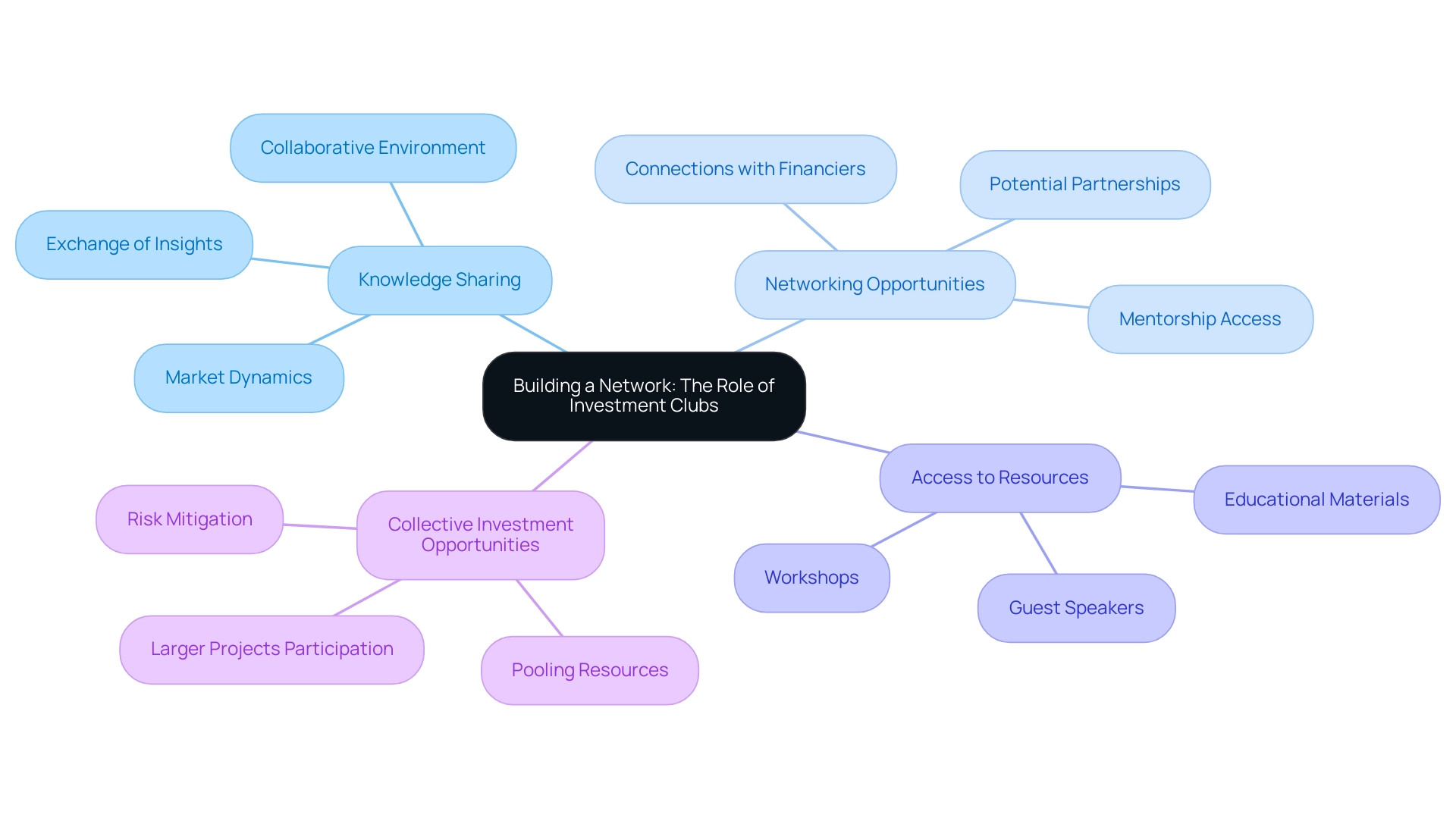
Essential Skills for New Real Estate Investors
For new real estate participants, cultivating a robust skill set is crucial for navigating the complexities of the market. The following essential skills should be prioritized:
- Market Research: A deep understanding of local market trends, property values, and economic indicators is vital. Effective market research allows individuals to identify lucrative opportunities and make informed decisions. Statistics indicate that a significant portion of successful individuals attribute their achievements to thorough market analysis. Furthermore, with digital economy characteristics, logistics, and storage facilities recognized as prime opportunities for real estate proprietors and stakeholders over the next 12 to 18 months, remaining updated on current trends is crucial.
- Financial Analysis: Mastering financial metrics such as cash flow, return on equity (ROE), and net present value is essential for assessing potential ventures. Individuals equipped with strong financial analysis skills can better evaluate the viability of properties and forecast future performance, ultimately leading to more strategic choices in funding.
- Negotiation: The ability to negotiate favorable terms with sellers, buyers, and lenders can significantly impact one's bottom line. Successful negotiation strategies not only secure better deals but also foster long-term relationships within the industry. Research indicates that almost 75% of sellers would opt to collaborate with their agent once more, emphasizing the significance of proficient negotiation in fostering trust and rapport.
- Risk Management: Identifying potential risks and formulating strategies to minimize them is an essential skill for any individual involved in investing. This includes understanding market volatility, property-specific risks, and broader economic factors. By proactively managing risks, stakeholders can protect their assets and strengthen their resilience in fluctuating markets.
- Networking: Establishing a robust network of connections with other stakeholders, property agents, and industry experts is invaluable. Networking not only opens doors to new opportunities but also provides access to insights and resources that can aid in decision-making. Engaging with a community of like-minded individuals can lead to collaborative ventures and shared knowledge. Moreover, as the property workforce encounters a gap due to retirements, aligning values with younger professionals and investing in upskilling initiatives can be advantageous for new participants in understanding industry dynamics.
By refining these skills, new participants can position themselves for success in the competitive property landscape, ultimately paving the way for wealth creation and sustainable growth.
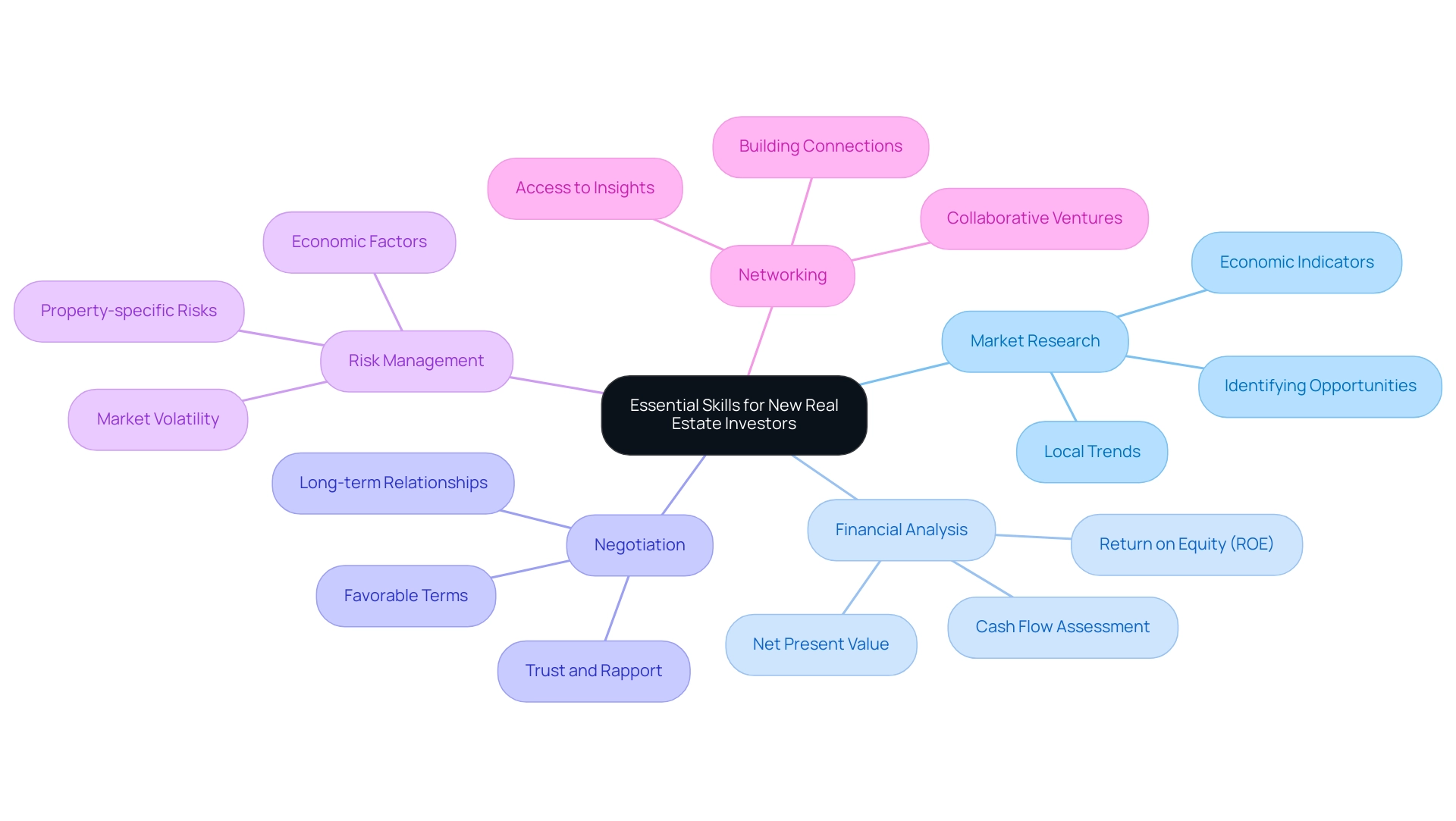
Recommended Resources for Learning About Real Estate Investing
To deepen your understanding of real estate investing, explore the following resources:
- Books: Essential titles such as The Millionaire Real Estate Investor by Gary Keller and The Book on Rental Property Investing by Brandon Turner lay a solid foundation for aspiring investors. Additionally, ABC's of Real Estate Investing by Ken McElroy is particularly beneficial for beginners, covering critical skills like property evaluation and deal negotiation.
- Online Courses: Platforms like Coursera and Udemy provide a range of courses centered on property investing techniques and financial analysis, accommodating various levels of expertise. These courses are designed to equip you with practical skills and insights necessary for successful investing.
- Podcasts: Engaging shows like the BiggerPockets Podcast feature interviews with experienced individuals and industry specialists, providing real-world insights and strategies that can inspire and inform your financial journey.
- Websites: Online resources like BiggerPockets and Investopedia are invaluable for property investors, offering an abundance of articles, forums, and tools that address a broad array of subjects, from market trends to financial strategies.
- Statistics: Keep in mind that Zero Flux gathers 5-12 selected property insights each day, ensuring you have access to tailored information that can inform your financial choices.
- Expert Insights: As Grant Cardone states, "In this real estate investing book, Grant Cardone explained how he made almost $1 billion through his property investments," highlighting the potential for significant wealth creation through informed investing.
- Inclusivity in Investing: Consider the insights from Ashley Wilson's book, which compiles experiences from 20 successful women in finance, addressing the challenges faced in a predominantly male industry. This viewpoint encourages inclusivity and provides valuable strategies relevant to all stakeholders.
Utilizing these resources can greatly enhance your understanding and efficiency as a property investor, allowing you to navigate the intricacies of the market with confidence. Remember, investing in real estate necessitates knowledge, strategy, and continuous learning to succeed.
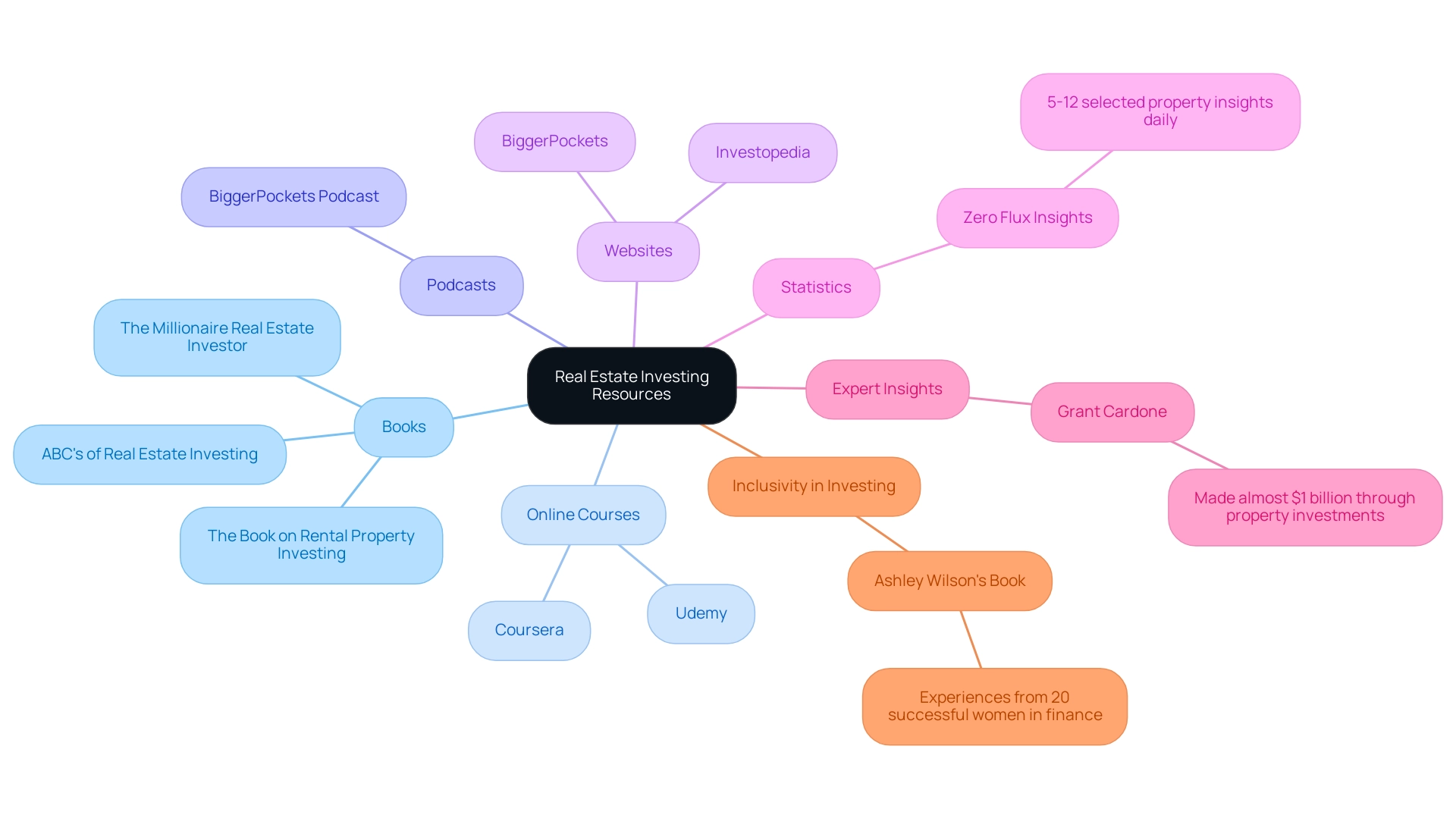
Conclusion
Private real estate investing presents a transformative opportunity for individuals aiming to grow their wealth and diversify their portfolios. As the landscape evolves, a significant shift towards private investments is anticipated to represent a considerable portion of the market by 2025. Investors have the option to choose from various strategies, including:
- Buy-and-hold
- Fix-and-flip
- Real estate syndication
- Commercial real estate
Each strategy is tailored to meet distinct goals and risk tolerances. Understanding these strategies is crucial for making informed decisions that align with personal financial objectives.
Establishing clear investment goals using the SMART framework is essential for success. By identifying income, appreciation targets, and investment horizons, investors can create focused strategies that lead to better outcomes. Moreover, a robust financial plan that encompasses budgeting, cash flow analysis, and contingency planning is vital for navigating the complexities of real estate investments. Due diligence in property evaluation, market analysis, and legal checks cannot be overlooked, as these steps are fundamental to mitigating risks and ensuring sound investment choices.
Building a strong network through real estate investment clubs and leveraging online platforms for access to opportunities can significantly enhance an investor's journey. The importance of continuous learning through recommended resources, courses, and expert insights is pivotal for adapting to market changes and maximizing returns. As the private real estate market continues to grow, embracing innovative approaches and staying informed will empower investors to capitalize on emerging trends and ultimately achieve their financial goals.




